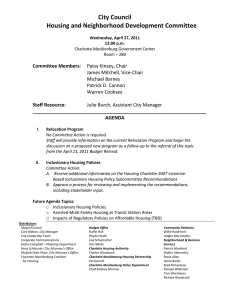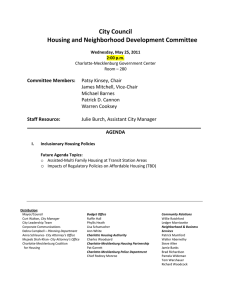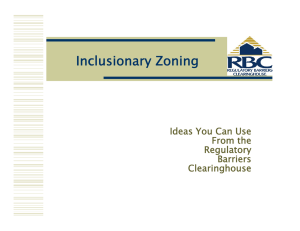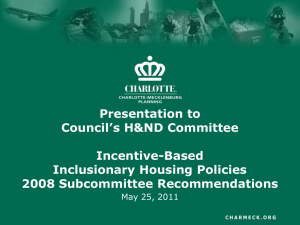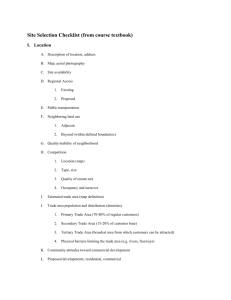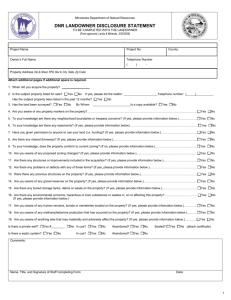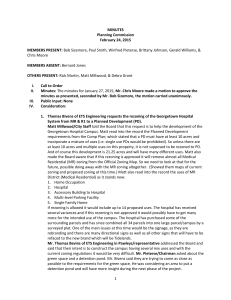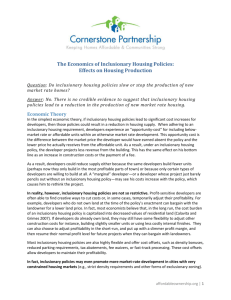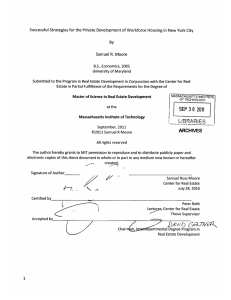Access slides - National Housing Conference
advertisement
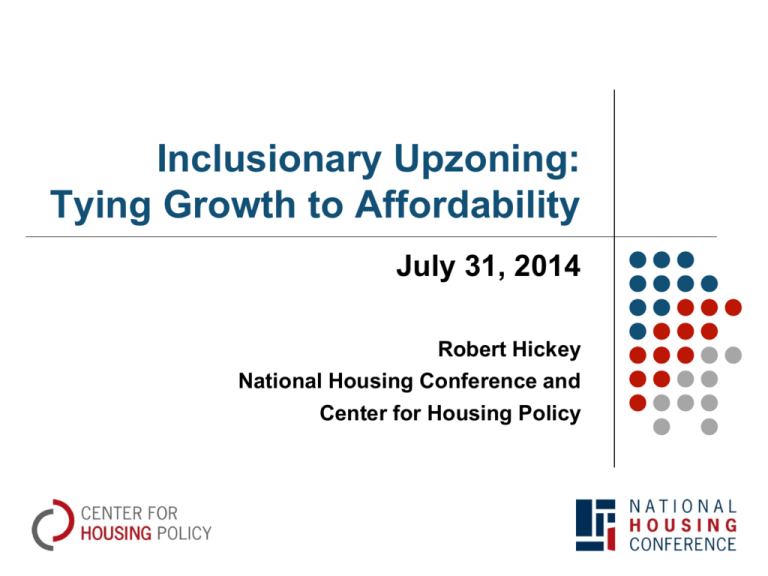
Inclusionary Upzoning: Tying Growth to Affordability July 31, 2014 Robert Hickey National Housing Conference and Center for Housing Policy Presenter Robert Hickey Senior Research Associate Center for Housing Policy and National Housing Conference Email: rhickey@nhc.org Twitter: @housingRobert Thank You to Our Sponsors New Report: Inclusionary Upzoning: Tying Growth to Affordability To download: http://www.nhc.org/publications/index.html Questions & Technical Details • A link to view the presentation and download slides will be emailed to everyone who registered • Ask questions via the Questions box in your GoToWebinar module • Use the Help menu or visit http://support.citrixonline.com/ Context • • • • • Rents have been rising faster than incomes Concerns about displacement Persistent exclusionary development patterns Imbalanced communities; jobs/housing disconnect Market isn’t fixing these problems on its own • Cities and close-in urban suburbs growing • Upzoning to meet the demand Inclusionary Housing • Local land use planning and zoning tools that require or incentivize the inclusion of lowerpriced, income-targeted housing in marketrate development • Can include policies that operate outside of the zoning code (for example in general land use plans, neighborhood/area plans, executive orders) Land Use Tool for… • Supporting balanced communities • Creating opportunities for affordable workforce housing near jobs; • Fostering and sustaining inclusive communities • Ensuring that limited remaining land can accommodate a diversity of housing needs • Addressing pressing affordability challenges Scale of Inclusionary Housing Number of Policies Source: Hickey, Sturtevant and Thaden (2014). Achieving Lasting Affordability through Inclusionary Housing. Inclusionary Housing Expanding • Over 500 policies to date • 27 states and Washington, DC • More than 3/4s of programs in NJ, CA, and MA, but surprising numbers in other coastal states and regions (especially CO,NY, RI, & NC) • No major drop off in programs during the housing downturn Limitations on Availability • Legal impediments in some states • Market barriers • Political challenges Is Upzoning an Opportunity? • Could tying these zoning changes to affordability be a helpful way to engage private developers where political, legal, or market barriers have historically impeded inclusionary housing strategies? Types of Inclusionary Upzoning 1. Incentive: Applies in Upzoned Areas 2. Incentive: Applies Wherever a Developer Seeks Zoning Changes/Relief 3. Mandatory In Upzoned Neighborhoods 1. Incentive: Applies in Upzoned Areas Arlington County • Form-based code overlay • Requirement tied to scale of redevelopment • Too early to see impact (3 proposals submitted) Fairfax County • Tysons Corner Plan • Development proposals for nearly all available development space • 1,000 units under construction • If built out: 2,500 affordable units; $64.5 million in commercial contributions New York City • Designated Areas Program • Generally high rate of uptake for density incentive • Property tax exemption • 2,888 affordable units • Not inclusive of all development in city • Shifting to mandatory Santa Monica • Land Use and Circulation Element (LUCE) • By-right heights of 32-36 feet with “Tier 2” and “Tier 3” height bonuses • Conditional use permit and development agreements 2. Incentive-Based: Applies Wherever a Developer Seeks Zoning Changes Boston • IDP applies to developerinitiated requests for zoning relief • Also when developers opt to utilize new terms of a comprehensive rezoning • 1,076 affordable units • $36.3 million in fees inlieu 3. Mandatory In Upzoned Neighborhoods Redmond • Population of 56,000 • Incorporated on neighborhood-byneighborhood basis • 7 areas of city • 308 affordable units Context Affects Impact Especially well suited to communities that have: • Hot housing markets (or soon to be hot) • Low base zoning restrictions • Residents supportive of greater development intensity Policy Design Affects Impact • Broad vs. narrow geographic applicability • Commercial as well as residential development types • For voluntary policies, specific-area plans and zoning overlays allow for tailored incentives and affordability expectations Follow-up Research • What share of the millions of new housing units needed between now and 2050 will necessitate rezoning? What share of new commercial development? • Which of the large cities nationwide that are experiencing sizeable housing demand have not yet made major changes to increase permissible heights or densities through their zoning code? Follow-up Research (cont.) • G ƒ iven the importance of location in inclusionary housing policies, will inclusionary upzoning adequately distribute affordable housing throughout a jurisdiction, especially in areas with high performing schools, access to jobs, and healthy living environments? “By 2050, the population is projected to reach about 400 million—a 28 percent increase. As a nation, we will have to build more than 30 million new housing units to accommodate this growth, and millions more to replace older housing units that are abandoned or torn down. We have to choose whether to build these new units in the same fragmented, segregated patterns as in past decades, or whether we will begin to move towards a society in which there is less socioeconomic differentiation between communities. The decisions we make or fail to make about metropolitan development will go a long way to determining whether all citizens will have access to quality housing, safe neighborhoods, economic opportunity, and quality education for their children.” —PAUL JARGOWSKY Professor of Public Policy, Rutgers University, 2013 Questions and Comments
